A horse travels at four gaits: the walk, trot, canter, and gallop. The average horse’s walk speed is 6.4 km/h. At the walk, the horse moves in a four-beat succession in the order shown, right. There is always one foot raised and three on the ground.
The walk is the slowest of the horse’s gaits as it has more upwards motion than horizontal motion (so if the vector of the horse’s velocity were broken down at walk, its vx would be smaller than its vy.) The horse moves its head and neck in a slight up and down motion which helps it to maintain balance as a horse is not particularly well balanced on three legs. This up and down motion increases as the speed of the walk increases.
Most horses have a trot of about 13 km/h. At the trot, the horse moves in a two-beat gait in which the legs move in diagonal pairs. There is no need for the up and down motion of the head and neck as in the walk because the horse is much better balanced at the trot (since they are balanced with one leg on either side touching the ground).
The trot is powered by the hind end of the horse and is much more springy and elastic than the walk because the horse’s hindquarters contain most of the muscle in the horse (in fact, a horse has no muscle below its front knees, only tendons and ligaments). The hindquarters push a horse forward at the trot, allowing for more movement in the x-direction.
The canter and gallop are very similar. The canter ranges from about 16-27 km/h. The canter is a three-beat gait which, if listened to, sounds like three beats, then a short pause, then another three beats. See picture, right, for gait sequence.
At the gallop, horses travel at about 40-48 km/h on average. The gallop is much like the canter in the progression of the beats however the gallop is actually a four-beat gait. This is simply because, in the second beat of the canter where the horse’s hind leg and opposite front leg are on the ground at the same time, the gallop has the horse putting down its hind leg slightly before the opposite front leg.
The gallop is much like the canter, except that the canter has a good deal of upwards motion (vy) and can be “collected” by the rider to have even more of this upwards motion, whereas the gallop is an extended version of the canter in which the horse fully extends its legs in a horizontal direction (vx) rather than a vertical direction.
This is why the gallop is so much faster than the canter. However, it is more difficult for a horse to jump from the gallop than from the canter, so horses must be collected for the last few strides as they approach a jump.
The reason that it is more difficult for a horse to jump from the gallop than the canter is because in order to jump, the horse must have both hind legs on the ground and both forelegs in the air, an unnatural position (from the point of view of the natural way of moving at a canter or gallop). In order to do this, the horse must be collected enough that it is able to shift its weight onto its hind end to propel itself upwards.
This is not possible at the gallop, which is a fully extended gait. Jumping from a gallop results in a poor bascule (arc) over the jump, which is both bad form for the jumping horse and also often results in the horse’s legs hitting the jump since it is jumping in a flat manner.
However, if the aim is to produce a racehorse, this travel in a flat manner is desirable because the horse can move at greater speeds. According to Newton’s second law, the force required to accelerate a mass with an acceleration in the direction of the applied force is equal to the product of the mass and the acceleration. Therefore, if there are multiple horses moving at the same acceleration and exerting the same force, the horse that will win has the greater mass – in other words, a larger horse is preferable.
When a rider negotiates the horse from one jump to the next, the rider must be able to adequately judge the length between jumps and the length of the horse’s stride (velocity). The jump is a projectile motion in which the horse is launched off the ground by its hind legs, making an arc over the jump and hitting the ground with its front legs.
The rider’s goal while jumping a horse is to ensure that the maximum height attained by the horse is directly over the jump, which has to do with the takeoff point of the horse. If the horse takes off too close to the jump, the jump will be hit by the horse’s hind legs as it propels itself off the ground. If the horse takes off too far away from the jump, the jump will be hit by the horse’s front legs as the horse lands.
When a horse is competing in sports such as cross-country jumping, where the jumps are very solid and the horse cannot knock them down, this ability of the rider to place the horse at its maximum height directly over the jump becomes very important. Because of Newton’s third law (every action has an equal and opposite reaction), if a horse hits a solid jump, the jump pushes back on the horse and the horse could fall down, depending on the magnitude of the force with which the horse has hit the jump.
Due to a horse’s large mass, its acceleration due to gravity creates a large amount of force and a horse can be severely injured by this force (because of Newton’s second law, force is equal to mass times acceleration).
Another difficulty presented to the rider is that horses are sometimes unwilling to perform the task the rider has asked. If a horse stops suddenly, unless the rider is exerting a force backwards (an external unbalanced force) the rider will fall because of Newton’s first law. Newton’s first law states that objects in motion will continue to stay in motion unless acted on by an external unbalanced force. So if the rider is moving at a constant velocity and the horse stops, the rider will continue to move with constant velocity, as pictured above right.
The main aspect of design related to the horse’s performance is the saddle, which is the piece of tack (equipment) which the rider sits on. If this piece of equipment is incorrectly placed or fitted to the horse it can prevent the horse from moving naturally or even cause injury. As well, the added weight of a rider has significant effects on the horse’s movement. The saddle is placed directly behind the horse’s shoulders because that is the horse’s center of gravity.
The saddle is designed to interfere as little as possible with the horse’s natural movement, however often the pressure to the horse’s shoulders causes the horse to be unable to reach forward as freely with its forelegs as is normal for a horse without a rider. The added weight of a rider can be problematic if the rider is not skilled enough to stay with the horse and move their body in the same rhythm as the horse’s motion. If the rider is unable to do this, the horse will often not comply with the rider’s commands because it is uncomfortable for the horse.
There have been vast technological improvements made in the saddle. When horses were first introduced as animals to be ridden (rather than eaten), they were ridden without saddles. This probably changed the horse’s capacity of motion significantly because the horse’s back, the source of all motion, was being sat upon very heavily. Later, people began to ride with simple clothes.
Eventually, the tree was developed (a hard part of the saddle running down the middle along the horse’s spine which keeps the rider’s weight entirely off of the horse’s back), which helped keep the rider’s weight off the horse’s sensitive spine.
The other important invention concerning saddles that helped the horse’s motion greatly were stirrups (a metal ring that holds the foot of the rider and is attached to the saddle by a strap.) This allowed the rider to stay off the horse’s back even more because the rider could stand up in the saddle. This was extremely beneficial to the horse’s range of motion, allowing the horse to go over jumps or move quickly without having the rider as essentially dead weight on top of their shoulders.
When a horse is jumping, they ideally jump in with a parabolic shape. With an unskilled rider who lands with a large force on a horse’s back (force created by Newton’s second law, gravity being the acceleration and the rider being the mass), the parabolic shape can be compromised and the horse may come down to the ground more suddenly and not in an even arc, likely knocking down the jump. Good stirrups help the rider to stay above the horse’s motion for the full time of the jump.
It is essential that the rider’s weight does not compromise the horse’s movement and that saddles are built to help the rider keep their weight off of the horse’s back. Horses did not evolve to carry weight on their back and so the weight of a rider can be very damaging to the horse’s back, because of Newton’s second law.
When the horse is in trot, the rider usually posts – that is, stands up and sits down on alternate beats, to make it more comfortable for the rider since the trot can be uncomfortable to sit. However, according to Newton’s second law, force is equal to mass times acceleration, so if the rider is very heavy, and the rider is accelerating downwards due to the force of gravity, they can exert considerable force on the horse’s back. T
he tree and the stirrups of the saddle help to diffuse this force from the center of the horse’s back, which is quite sensitive.
The force of friction acts on a horse’s hooves, primarily. The hooves of a horse are similar to a human’s fingernails, in that they continue to grow. A wild horse walks several miles a day looking for food and wears down his hooves from the friction in this manner. However, horses in heavy work from riding can wear their hooves down too much, and so often metal shoes are nailed on to their feet.
If a horse is participating in an event where they are going to be galloping across a grassy field, often their owners will put studs in their shoes, which increases the force of friction. Studs are small nails that stick out from the horse’s shoe, making it easier to grip on slippery surfaces and creating a larger force of friction, pictured above right. It is essential to have a large force of friction so that the horse can push off of the ground without slipping.
Works Cited
“Effects of Girth, Saddle and Weight on Movements of the Horse.” U.S. National Library of Medicine.
December 2004. National Institute of Health. 2 March 2011.
<http://www.ncbi.nlm.nih.gov/pubmed/15656511>
“History of the Saddle.” 2 March 2011.
<http://www.limebrook.com/saddlehistory.html>
Meyer, Colleen. “Saddle Fitting, Scientific Method, and Parabolic Skis.” Becoming a Saddle Fitter. 28
December 2008. Advanced Saddle Fitting. 10 April 2011.
<http://advancedsaddlefit.com/2008/12/28/saddle-fitting-scientific-method-and-parabolic-skis/>
Nicholson, Nancy. “Biomechanical Riding and Dressage.” 2 March 2011.
<http://nicholnl.wcp.muohio.edu/DingosBreakfastClub/BioMech/BioMechRide1.html>
“The Physics of Riding Horses.” 4 April 2011.
<http://clackhi.nclack.k12.or.us/physics/projects/Final%20Project-2005/6-Final%20Project/HorseJump/index.html>

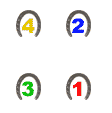
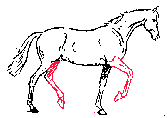
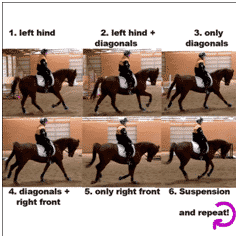
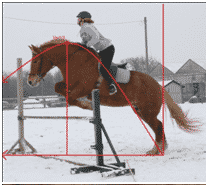
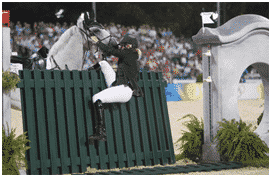
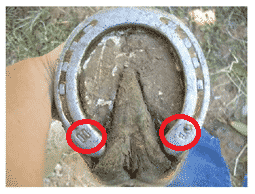
This was really helpful! Thank you so much! It makes science so much easier when its applied to something you love! 🙂